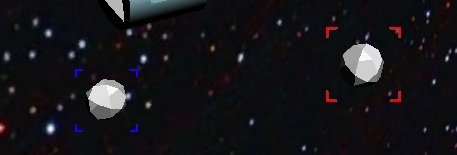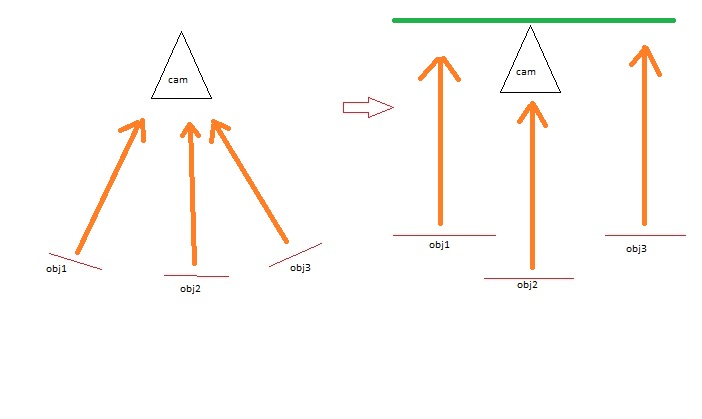- Home /
hud targetmark behind the screen
hello guys
I have a targetmarker hud

what works quite well. not perfect, but it's just the beginning. What I would like to solve is to draw the hud in the distance with the object it marks. It cant be an object, as other objects will then hide it when in front of it. I need it to be compatible with real3d.
current script is:
using UnityEngine;
using System.Collections;
using System.Collections.Generic; //Use this so you can manipulate Lists
public class GUIRadar : MonoBehaviour
{
public Texture2D targetIcon; //The target icon that will be placed in front of targets
public Texture2D targetIcon1; //The target icon that will be placed in front of targets
public Texture2D targetIcon2; //The target icon that will be placed in front of targets
public float maxTargetIconSize = 300f; //The maximum size of icons when close to the target
public float minTargetIconSize = 0f; //The minimum size of icons when they appear (far from the target)
public float maxDistanceDisplay = 10f; //The maximum distance from where you can see the icons appearing
public float minDistanceDisplay = 2f; //The minimum distance from where you see the icons disappearing when too close
public float smoothGrowingParameter = 25f; //The speed of the growing effect on icons
public float smoothMovingParameter = 25f; //The moving speed of items : high values means the icon is "attached" to the item
public bool directViewEnabled = true; //If you want to allow icon display even if targets aren't in direct view for the player
public struct TargetStruct //Structure that contain every icon informations
{
public GameObject item; //-the item the icon is linked to
public Vector3 screenPos; //-the screen position of the icon (!= world position)
public float xSize, ySize; //-the current size of the icon on the screen
public float xPos, yPos; //-the current coordinates of the screen position
public float xTargetSize, yTargetSize; //-the coordinates you want the icon to reach
public float xTargetPos, yTargetPos; //-the size you want the icon to reach on the screen
public float distance; //-the distance between player and the item linked to the icon
public bool directView; //-tells you if the item is in direct view or not
}
public List<TargetStruct> TargetList = new List<TargetStruct>();//Your ICONS LIST
public GameObject[] Targets; //The GameObjects considered as targets
private int targetsCount; //Number of targets in the scene
void Awake()
{
TargetList.Clear();
Targets = GameObject.FindGameObjectsWithTag("target"); //Get all the potential targets in the scene (just replace it by your own tag : "MyTag")
foreach(GameObject target in Targets) //Put every detected GameObject into your ICONS LIST
{
TargetStruct newTarget = new TargetStruct();
newTarget.item = target; //and attach each icon its GameObject
TargetList.Add(newTarget);
}
Targets = GameObject.FindGameObjectsWithTag("target1"); //Get all the potential targets in the scene (just replace it by your own tag : "MyTag")
foreach(GameObject target in Targets) //Put every detected GameObject into your ICONS LIST
{
TargetStruct newTarget = new TargetStruct();
newTarget.item = target; //and attach each icon its GameObject
TargetList.Add(newTarget);
}
Targets = GameObject.FindGameObjectsWithTag("target2"); //Get all the potential targets in the scene (just replace it by your own tag : "MyTag")
foreach(GameObject target in Targets) //Put every detected GameObject into your ICONS LIST
{
TargetStruct newTarget = new TargetStruct();
newTarget.item = target; //and attach each icon its GameObject
TargetList.Add(newTarget);
}
targetsCount = TargetList.Count; //Count the number of target in the scene
}
void Update()
{
for(int i = 0; i<targetsCount; i++) //You have to repeat it for every icons : be aware that if you have too much that could use a lot of ressoures
{
TargetStruct target = new TargetStruct(); //You have to create a temporary TargetStruct since you can't access a variable of an element in a list directly
target = TargetList[i]; //You take the item attached to the icon
target.screenPos = camera.WorldToScreenPoint(target.item.transform.position); //Convert world coordinates of the item into screen ones
target.distance = Vector3.Distance(target.item.transform.position, transform.position); //Get the distance between item and player
Debug.Log(target.distance);
if(target.distance>maxDistanceDisplay || target.distance<minDistanceDisplay) //If the item is too far or too close
{
target.xTargetSize = minTargetIconSize; //you want it to disappear
target.yTargetSize = minTargetIconSize; //or at least to be in its smaller size
}
else
{
target.xTargetSize = maxTargetIconSize/(target.distance); //Else you get its size with the
target.yTargetSize = maxTargetIconSize/(target.distance); //distance : far<=>small / close<=>big
}
if(target.distance>maxDistanceDisplay) //If the item is too far, you set its screen position : (this way it seems as if the icon was coming away from the screen to focus your target)
{
if(target.screenPos.x<Screen.width/2) //-if it's under the center of the view field
target.xTargetPos = 0; //to the bottom of the screen
else //-else
target.xTargetPos = Screen.width; //to the top of the screen
if(target.screenPos.y<Screen.height/2) //-if it's on the right of the view field
target.yTargetPos = Screen.height; //to the right of the screen
else //-else
target.yTargetPos = 0; //to the left of the screen
}
else //If the item is NOT too far, you set its screen position :
{
target.xTargetPos = target.screenPos.x-target.xSize/2; //in x-axis to the item's x-position minus half of the icon's size
target.yTargetPos = Screen.height-target.screenPos.y-target.ySize/2; //in y-axis to the item's y-position minus half of the icon's size
}
target.xSize = Mathf.Lerp(target.xSize, target.xTargetSize, smoothGrowingParameter*Time.deltaTime); //You do lerps on your icons size so you can adjust
target.ySize = Mathf.Lerp(target.xSize, target.yTargetSize, smoothGrowingParameter*Time.deltaTime); //the speed of their resizing
target.xPos = Mathf.Lerp(target.xPos, target.xTargetPos, smoothMovingParameter*Time.deltaTime); //You do lerps on your icons position so you can adjust
target.yPos = Mathf.Lerp(target.yPos, target.yTargetPos, smoothMovingParameter*Time.deltaTime); //their moving speed
RaycastHit hitInfos = new RaycastHit(); //You create a new variable to stock the information of the coming raycast
Physics.Raycast(transform.position, target.item.transform.position-transform.position, out hitInfos); //and you RayCast from the player's position to the item's position
/*if(hitInfos.collider.gameObject.layer==8) //HERE IS A BIT TRICKY : you have to creat new layers (I called them "Interactive Items" and "Obstacles") and to apply them to your various items.
target.directView=true; //Then you select EVERY items in your scene and set their layer to "Ignore Raycast". After that you select your interactive items biggest shape (if you have big trigger colliders on them select the item that hold it),
else*/ //and set their layers to "Interactive Items". Last part is setting every potential obstacle item layer to "Obstacles".
target.directView=false; //NOTE : Here my "Interactive Items" layer number is 8
TargetList[i] = target; //You apply all the variables to your index-i icon in the ICONS LIST
}
}
void OnGUI()
{
for(int i = 0; i<targetsCount; i++) //For every icon
{
if(TargetList[i].screenPos.z>0 && (!directViewEnabled || (directViewEnabled && TargetList[i].directView))) //If the icon is in front of you and all the required conditions are okay
{
if(TargetList[i].item.tag=="target")
GUI.DrawTexture(new Rect(TargetList[i].xPos, TargetList[i].yPos, TargetList[i].xSize, TargetList[i].ySize), targetIcon);//you display the icon with it's size and position
if(TargetList[i].item.tag=="target1")
GUI.DrawTexture(new Rect(TargetList[i].xPos, TargetList[i].yPos, TargetList[i].xSize, TargetList[i].ySize), targetIcon1);//you display the icon with it's size and position
if(TargetList[i].item.tag=="target2")
GUI.DrawTexture(new Rect(TargetList[i].xPos, TargetList[i].yPos, TargetList[i].xSize, TargetList[i].ySize), targetIcon2);//you display the icon with it's size and position
}
}
}
}
Thanks in advance
Answer by Statement · Dec 10, 2013 at 11:27 PM
It can be an object, if you change the render order for it. You may also be able to change the sorting order with Renderer.sortingOrder but I've not used it so I don't know if it'll do what you want. If you do use this, then you need to make sure that the objects you render also does not ZTest, because otherwise they would hide behind objects, which you don't want.
You can also render the item with a second camera with a different depth and layermask, but it may be overkill since Unity has to do culling for a lot of object anyhow, unless that has been addressed in a recent patch.
Anyway, leaving this as a comment since you may still want a solution with GUI.DrawTexture.
hmmm. the second camera might be a good idea. Thanks, i will try it. but also with objects i have a bit problem. I will need a lookat towards the camera but not exactly a lookat, but look into the direction of the camera into the infinite. do you have a solution for that?

I use the standard assets camera control script atm
(The second camera is likely one of the worse perfor$$anonymous$$g solutions since it likely has to clear the depth buffer and since it has to perform culling for all objects yet again - but I wouldn't worry. If it solves your problem, then use that now and know that you can fix that issue later if it actually ever becomes a real problem).
I guess you could just use a script that does Transform.LookAt, but it may be faster if you manage the objects vertices yourself and/or have a special shader that computes vertices where you want it. All in all it's just a basket of apples. At this point I don't think it matters how you solve it. I can be a bit stubborn sometimes and present a lot of solutions, for both good and harm. Another approach is to use the particle system. Just position the particles where you want them rendered and Unity will take care of the rendering.
For your drawing, I'd just set the rotation inverted to the cameras rotation. (Just take the rotation of the camera and rotate that 180 degrees) That way they would all be facing the same way.
Sigh, answers doesn't allow me to post an image to the comment. But draw a line from the camera. That line you already have. That's the forward direction of your camera. Now just apply the backward direction of your camera to be the forward direction of your objects.
\o/ thanks a lot. I've added a new layer "hud". I've put the marker object to that layer. camera1 ignore that layer while camera2 show only the "hud" layer (culling mask). then set the depth 0 for camera1 and 1 for camera2 and camera2 clear depth only. huzzah!!! it looks great and smooth for now :) ohhh, and I wasn't able to use lookat with an unknown reason for me but this works:`transform.forward = -1*target.forward;`
Your answer

Follow this Question
Related Questions
Best way to create mini hp-bars for enemies. 1 Answer
How to position 3D-GUI-Mesh on change of aspect ratio? 0 Answers
Runescape style window? 1 Answer
Multi Camera HUD buttons not working. 1 Answer
GUI Question please help. 2 Answers
